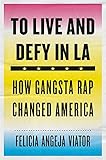To Live and Defy in LA : How Gangsta Rap Changed America / / Felicia Angeja Viator.
Material type: TextPublisher: Cambridge, MA : : Harvard University Press, [2020]Copyright date: ©2020Description: 1 online resource (304 p.)Content type:
TextPublisher: Cambridge, MA : : Harvard University Press, [2020]Copyright date: ©2020Description: 1 online resource (304 p.)Content type: - 9780674976368
- 9780674245853
- Gangsta rap (Music) -- Social aspects -- United States
- Gangsta rap (Music) -- California -- Los Angeles -- History and criticism
- Inner cities -- California -- Los Angeles
- Urban youth -- California -- Los Angeles
- SOCIAL SCIENCE / Popular Culture
- 1992 Riots
- Batterram
- Gangsta Rap
- Gangster rap
- L.A. Riots
- L.A.P.D
- Long Beach Riot
- Los Angeles Hip-Hop
- Most Dangerous Group
- N.W.A
- Priority Records
- Reality Rap
- Rodney King
- Ruthless Records
- Straight Outta Compton
- West Coast Rap
- 306.4/842490979494 23
- ML3918.R37 V53 2020
- ML3918.R37
- online - DeGruyter
| Item type | Current library | Call number | URL | Status | Notes | Barcode | |
|---|---|---|---|---|---|---|---|
 eBook
eBook
|
Biblioteca "Angelicum" Pont. Univ. S.Tommaso d'Aquino Nuvola online | online - DeGruyter (Browse shelf(Opens below)) | Online access | Not for loan (Accesso limitato) | Accesso per gli utenti autorizzati / Access for authorized users | (dgr)9780674245853 |
Frontmatter -- CONTENTS -- PREFACE -- INTRODUCTION. They Don't Even Know -- CHAPTER 1 . The Batterram -- CHAPTER 2 . Hardcore LA -- CHAPTER 3 . The Boys in the Hood Are Always Hard -- CHAPTER 4 . Somebody's Gonna Pay Attention -- CHAPTER 5 . Without a Gun and a Badge -- CONCLUSION . LA County Blues -- NOTES -- ACKNOWLEDGMENTS -- INDEX
restricted access online access with authorization star
http://purl.org/coar/access_right/c_16ec
How gangsta rap shocked America, made millions, and pulled back the curtain on an urban crisis. How is it that gangsta rap-so dystopian that it struck aspiring Brooklyn rapper and future superstar Jay-Z as "over the top"-was born in Los Angeles, the home of Hollywood, surf, and sun? In the Reagan era, hip-hop was understood to be the music of the inner city and, with rare exception, of New York. Rap was considered the poetry of the street, and it was thought to breed in close quarters, the product of dilapidated tenements, crime-infested housing projects, and graffiti-covered subway cars. To many in the industry, LA was certainly not hard-edged and urban enough to generate authentic hip-hop; a new brand of black rebel music could never come from La-La Land. But it did. In To Live and Defy in LA, Felicia Viator tells the story of the young black men who built gangsta rap and changed LA and the world. She takes readers into South Central, Compton, Long Beach, and Watts two decades after the long hot summer of 1965. This was the world of crack cocaine, street gangs, and Daryl Gates, and it was the environment in which rappers such as Ice Cube, Dr. Dre, and Eazy-E came of age. By the end of the 1980s, these self-styled "ghetto reporters" had fought their way onto the nation's radio and TV stations and thus into America's consciousness, mocking law-and-order crusaders, exposing police brutality, outraging both feminists and traditionalists with their often retrograde treatment of sex and gender, and demanding that America confront an urban crisis too often ignored.
Mode of access: Internet via World Wide Web.
In English.
Description based on online resource; title from PDF title page (publisher's Web site, viewed 18. Sep 2023)


